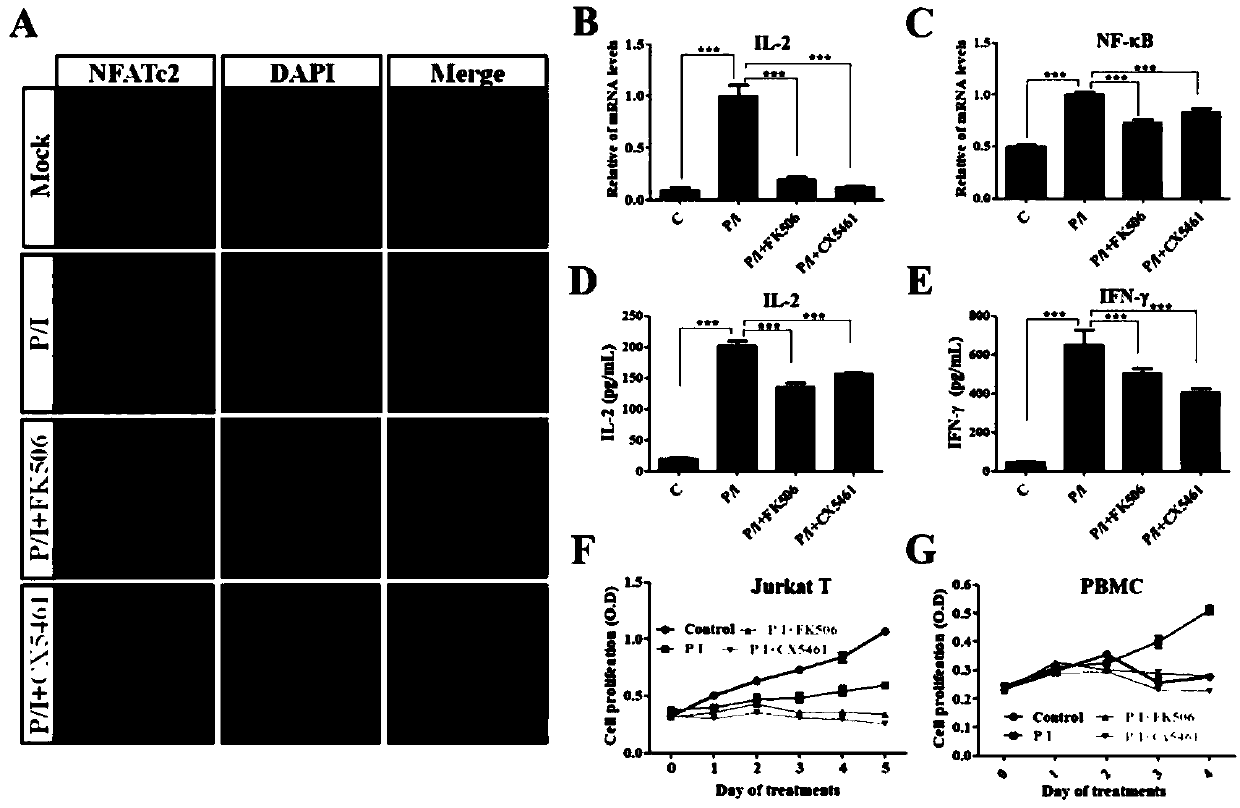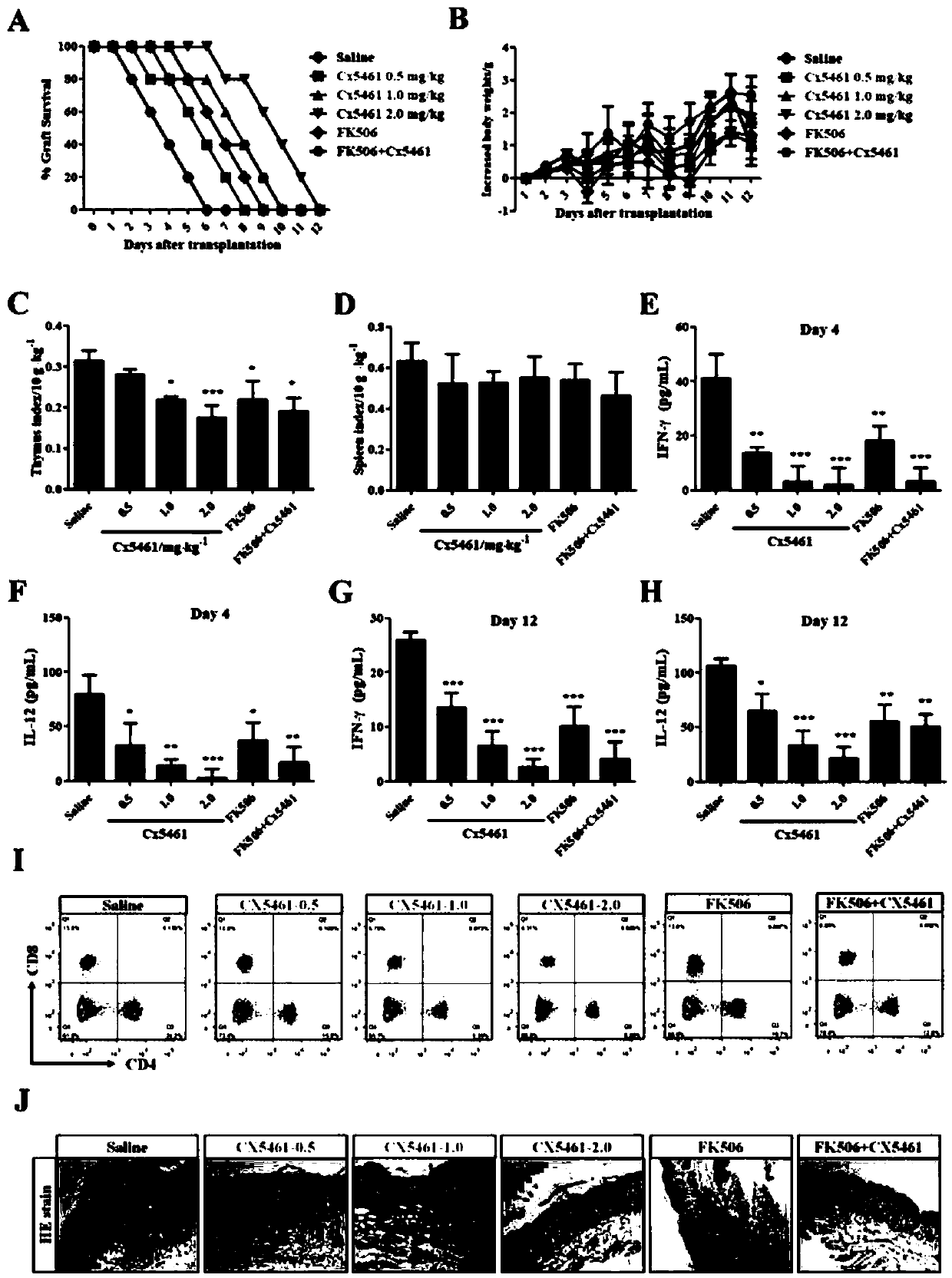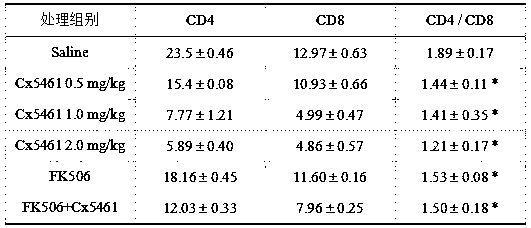Novel use of Polymerase I inhibitor
A technology of inhibitor and immunosuppressant, applied in the field of biomedicine, can solve the problem that the effect of CX-5461 has not been reported, and achieve the effect of inhibiting the proliferation of T cells and having great application prospects.
- Summary
- Abstract
- Description
- Claims
- Application Information
AI Technical Summary
Problems solved by technology
Method used
Image
Examples
Embodiment 1Cx5461
[0047] Example 1 Cx5461 affects T cell activation by inhibiting the proliferation of T cells
[0048] Dissolve Cx5461 in dimethyl sulfoxide (DMSO) to prepare Cx5461 solution for the following experiments:
[0049] 1. Inoculate Jurkat T cells in a six-well plate in RPMI1640 medium containing 10% fetal bovine serum, and divide them into four groups.
[0050] (1) Stimulation group (P / I): Add PMA / Ionmycin solution to each well;
[0051] (2) Positive control group (P / I+FK506): Add FK506 solution to each well until the concentration of FK506 is 1×10 -6 M;
[0052] (3) Experimental group (P / I+Cx5461): Add Cx5461 solution to each well until the concentration of Cx5461 is 1×10 -6 M;
[0053] (4) Control group (Con): add an equal volume of DMSO to each well;
[0054] Immunofluorescence experiments were performed after the above four groups were cultured at 37° C. for 6 hours. Suspend Jurkat T cells in 50 mL medium, install filter paper and fix slides on the cell spinner, then add ...
Embodiment 2Cx546
[0077] Example 2 Cx5461 Delays the Rejection of Skin Allografts at the Animal Experimental Level
[0078] Take 2 g of Cx5461 and dissolve it in 1 mL of DMSO. After the dissolution is complete, add physiological saline to supplement the volume, so that the final concentration of Cx5461 is 0.5 g / L, 1.0 g / L, and 2.0 g / L to obtain a Cx5451 solution. experiment:
[0079] 1. Mouse skin transplantation experiment
[0080] (1) Establishment of mouse skin graft model
[0081] C57BL / 6 and C57BL / 6 at the age of 6-8 weeks were purchased from the Guangdong Provincial Medical Experimental Animal Center and kept in the feeding room of Shenzhen Graduate School of Tsinghua University. Two days before the operation, the recipient C57BL / 6 mice were depilated; BALB / c mice and C57BL / 6 mice were anesthetized with 10% sodium pentobarbital, and then treated with 75% ethanol for donor and C57BL / 6 mice. The skin on the back of the recipient mouse is sterilized. The back skin of the donor mice was r...
PUM
 Login to View More
Login to View More Abstract
Description
Claims
Application Information
 Login to View More
Login to View More - R&D
- Intellectual Property
- Life Sciences
- Materials
- Tech Scout
- Unparalleled Data Quality
- Higher Quality Content
- 60% Fewer Hallucinations
Browse by: Latest US Patents, China's latest patents, Technical Efficacy Thesaurus, Application Domain, Technology Topic, Popular Technical Reports.
© 2025 PatSnap. All rights reserved.Legal|Privacy policy|Modern Slavery Act Transparency Statement|Sitemap|About US| Contact US: help@patsnap.com



